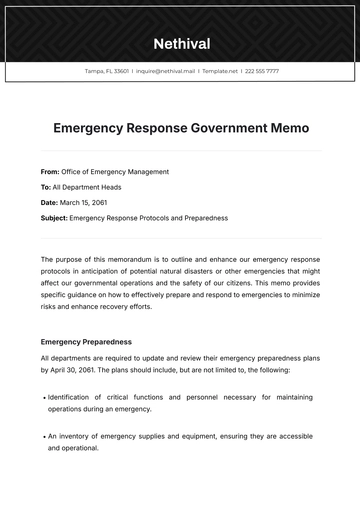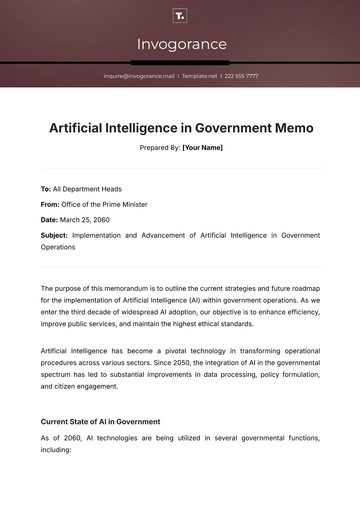Free Crisis Management Government Memo

Prepared By: [Your Name]
Subject: Coastal Flood Management Crisis
Background
In early June 2060, an unprecedented rise in sea levels caused severe flooding along the eastern coastline of the United States, impacting several major metropolitan areas. The surge, attributed to accelerated polar ice melt and extreme weather patterns, has resulted in significant damage to infrastructure, displacement of communities, and disruption of essential services. The situation demands immediate attention to mitigate adverse effects and prepare for potential future occurrences.
Objectives
The primary objectives of this crisis management plan are to ensure the safety and well-being of affected populations, restore critical infrastructure and services, and implement sustainable policies to prevent future occurrences. Our goals are to:
Evacuate vulnerable populations efficiently.
Provide urgent relief and essential services like food, water, and medical aid.
Repair and reinforce damaged infrastructure.
Develop long-term strategies for climate resilience and coastal protection.
Action Plan
Deploy emergency response teams to assess and assist in the worst-hit areas by June 15, 2060.
Establish evacuation centers with sufficient capacity for displaced persons; operational by June 20, 2060.
Collaborate with federal and local agencies to restore power and water utilities by July 5, 2060.
Initiate long-term coastal protection projects, such as sea walls and natural buffer zones, starting August 1, 2060.
Roles and Responsibilities
The Department of Homeland Security will coordinate overall crisis response efforts. State and local governments are responsible for implementing evacuation plans and managing local resources. The National Guard will assist in logistics and on-ground support. The Environmental Protection Agency will assess environmental impacts and guide restoration efforts.
Communication Strategy
An effective communication strategy is crucial for public safety and morale. We will establish a direct communication line with residents through social media updates, press releases, and emergency broadcasts. Local authorities will conduct community meetings to provide updates and instructions. Transparent and consistent messaging will be maintained to address public concerns and misinformation.
Risk Assessment
Potential risks include further flooding due to unpredictable weather patterns, resource shortages, and public unrest. Each risk will be mitigated by deploying rapid response teams, maintaining reserve supplies of essential goods, and ensuring constant communication between authorities and the public.
Resources Needed
The immediate allocation of financial resources for emergency services, infrastructure repair, and long-term coastal projects is essential. Additionally, personnel including engineers, medical teams, and environmental experts must be mobilized. Access to technology for monitoring and predictive analytics will be crucial for effective management.
Conclusion/Recommendations
To address this ongoing crisis efficiently, a coordinated effort at all government levels is required. In addition to current measures, we recommend establishing a task force dedicated to research and development of climate resilience policies. Future simulations should be conducted to better prepare for possible scenarios. Regular progress reviews and updates will ensure adaptive strategies are employed effectively. Immediate action, guided by compassion and data-driven decisions, will minimize the crisis impact and protect our communities for the future.
- 100% Customizable, free editor
- Access 1 Million+ Templates, photo’s & graphics
- Download or share as a template
- Click and replace photos, graphics, text, backgrounds
- Resize, crop, AI write & more
- Access advanced editor
-
Ensure effective communication during critical times with our Crisis Management Government Memo Template from Template.net. Fully editable and customizable, this template allows you to address urgent matters with precision and clarity. Whether you're drafting emergency plans or informing stakeholders, this template is ready to be tailored to your needs. Easily editable in our Ai Editor Tool for quick modifications and seamless use.





























